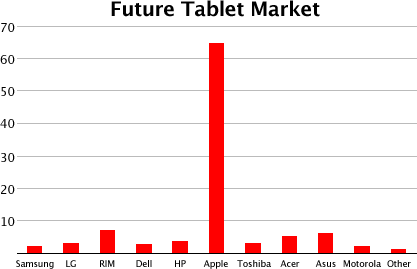The Best Spots Are Taken
One of Apple's great strengths has been the ability to identify what
prices in a product category are the most profitable. This is why Apple
hasn't pursued a low cost notebook - it won't exchange increased effort
for decreased profits.
Simple math: Assuming the same margins, Apple has to sell twice as
many $499 notebooks as $999
MacBooks to earn the same profit.
But often the lower cost item will not support the same margin, so
even more units must be sold. Apple conserves its resources without any
significant loss of profits by avoiding the low-end market.
The iPad Sets the Bar
This is a problem for everyone else when the potential customer asks
one simple question: "Why should I buy your tablet when I can buy
an iPad for the same price?"
This forces the competition to either sell for less or offer more
features and suffer the margin loss. Either choice requires more work
for the competition to match the profits that Apple is earning.
I like to think of the market as a parking lot, and with the iPad,
Apple has already taken all the spots up front.
Filtering the Noise
Noise is both annoying and something the human brain is good a
filtering out. If you visit someone who lives near an airport, the
planes might drive you crazy. The person who lives there has learned to
filter out the noise.
Today Apple has the dominant place in the tablet market, but
sometime in the near future other vendors will introduce their tablet
products. Whether due to increased market size due to the new tablets
or them actually stealing some iPad customers, Apple will loss market
share.

If Apple owns 65% of the market, others have to split the remaining
35%.
A time may come when Apple is reduced to 65% of the tablet market
and the rest is divided up among the competition. The graph will look
something like the one above. You can see that Apple brand stands out
against the rest. Sure, the competition has grabbed 35% market share
from Apple, but that 35% is broken up over so many companies that it
looks like noise.
All of the competing products and features are going get filtered
out, and people are going to continue choosing the brand that stands
out. Sure, some people will listen to the noise and pick one of the
other brands because it is $50 less or has a few extra features, but
those minor details won't be enough for the majority.
The more fractured the market is by the competitors, the more
important Apple will seem.
Apple Is a Moving Target
Apple has done a wonderful job innovating details not on the radar.
The competition could get ahead of Apple by releasing a 10 megapixel
camera when Apple offers "only" a 5 megapixel camera. (Yes, I know the
current iPad doesn't include this feature. It will come, and it's
already present on the iPhone 4.)
Apple will stay ahead by pulling out a host of novel technologies
that leave everyone else playing catch up.
Without knowing exactly what Apple will do, we can look at its other
products to see how Apple has left the competition guessing. The
original iPod took
everyone by surprise. No one was thinking that a company that only made
computers was going to develop and release an MP3 player - that was for
consumer electronics companies like Diamond, Sony, and Creative
Labs.
The iPad left Dell, HP, and many others years behind in the consumer
electronic business, and no one ever caught up.
That is why the success of the iPad scares everyone so much.
Apple Innovation
Among Apple's many innovations, they introduced backlit keyboards
with the first 17" MacBook
Pro. It introduced unibody construction with the first MacBook Air. Apple
released the original
iMac without a floppy drive and the MacBook Air without a built-in optical
drive. It never used a replaceable battery for the iPod or iPhone,
and it no longer does on any laptop. Apple moved the iPhone to the 960 x 640 Retina display while
the rest of the industry was competing with the 480 x 320 display on
earlier iPhones.
Some of these changes seemed crazy at the time, like dropping the
optical drive or moving to permanent batteries. Commentators have
ripped into Apple for many of these changes, yet Apple hasn't backed
down on any of them.
Leaving out the optical drive gave Apple's notebook a weight and
size advantage. Permanent batteries allow Apple to increase battery
capacity, and thus battery life, on portable electronics. Apple's
design choices are never random; they are focused on pushing design
acceptance for the next round of changes.
In hunting, it is easy to shoot a target that is running at a
constant speed by leading the shot. But how's the competition supposed
to do that if there is no predicting what crazy idea Apple will have
next? Apple doesn't just innovate, but they do it on unexpected
ideas.
The Old Way Won't Work
Years ago, Microsoft could just spend its way out of trouble. That
is not going to work here. Apple has the pocket change (over
$40 billion) to take on any stupid short-term challengers.
While I think that a carefully crafted strategy could take on the
iPad (see 5
Strategies Microsoft Must Use to Succeed Against the iPad), I am
nearly 100% sure that no one has got what it takes to make it happen.




